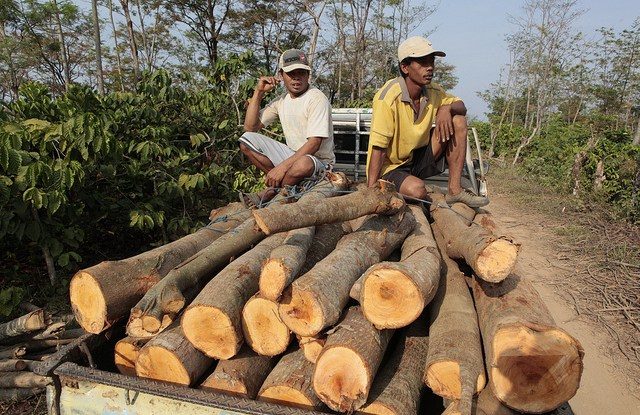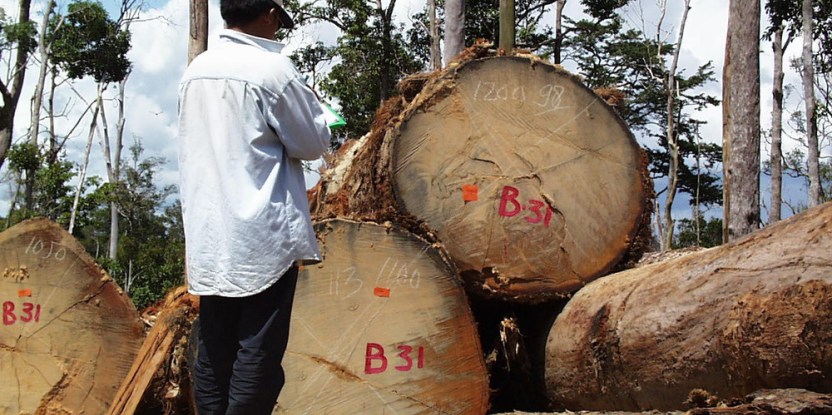
BOGOR, Indonesia — When it comes to stemming the global trade in illegal tropical timber, local activists in timber-producing countries may be more effective than sophisticated technology and import regulations, say experts from the Center for International Forestry Research (CIFOR).
Whistleblowing by environmental groups has led to some crackdowns on the illegal trade in high-profile species such as bigleaf mahogany from South America, and those groups should be given a more formal role in international oversight agencies, suggests a recent paper published by CIFOR and London-based Chatham House.
“Engaging civil society representatives from countries where the illegal timber trade occurs expands your information base, as long as they are credible non-governmental organizations,” said Rosalind Reeve, a senior associate researcher at CIFOR and co-author of the paper.
The report recommends ways to strengthen the relationship between European Union regulations aimed at curbing illegal timber imports and the Convention on International Trade in Endangered Species of Wild Fauna and Flora (CITES).
Between 15 percent and 30 percent of the timber traded on global markets is illegal, according to estimates by the UN Environment Program. Interpol estimates that the illicit trade is worth at least $30 billion a year.
Pressure from civil society groups helped lead to stricter controls on exports of ramin (Gonystylus spp.), which is native to Southeast Asian peat swamps, Reeve said. And campaigns by non-governmental organizations in Europe and the United States triggered a moratorium on exports of bigleaf mahogany (Swietenia macrophylla) from Brazil and tougher timber export requirements in a free trade pact between Peru and the United States. More recently, the environmental organization Greenpeace questioned a shipment of African teak (Pericopsis elata, also known as Afrormosia), which authorities then seized at a port in Belgium.
Although the European Union, the United States and Australia have established regulations for timber imports, they are unlikely to stop the flow of illegal timber, some experts say.
“It is widely recognized that illegal logging is still a serious problem in many parts of the world,” says Andrew Wardell, former director of CIFOR’s Forests and Governance Program. “The incentives are so large for the people involved, and enforcement capacities and possibly the political will to act are still in short supply.”
Even when international agencies and timber-producing countries agree on better forest management and enforcement measures, illegal shipments can slip through loopholes.
Despite a special section on forest governance in the US-Peru Trade Promotion Agreement, which requires Peru to ensure that shipments of CITES-protected timber species can be traced to the forest concession where the trees were harvested, illegal mahogany exports persist because of a lack of pre-harvest inventories, fraudulent or incomplete paperwork, and lack of enforcement, according to a study published in the journal Nature earlier this year.
An earlier investigation by the Environmental Investigation Agency found that since 2008, more than 20 US companies imported millions of dollars in illegal wood from the Peruvian Amazon. Illegally harvested mahogany eventually enters the legal market chain, so the export paperwork appears to be legitimate when it reaches ports in the United States, the biggest importer of Peruvian mahogany.
NO ‘TECHNO-CENTRIC’ SOLUTIONS
Inadequate regulation, poor enforcement and corruption are problems that can often be addressed more effectively by harnessing the knowledge of civil society organizations in the timber-producing countries than by international regulations such as the US Lacey Act or the EU Trade Regulation, Wardell said.
Importing countries can play an important role in supporting those organizations as they pressure for better regulation of forest management and timber exports at home, he said. Even when traditional importing countries such as the United States and those in the European Union pass laws to curb illegal timber imports, their ability to keep illegally harvested timber out of supply chains is limited for several reasons, Wardell said.
As researchers, we can contribute new, scientifically grounded knowledge and evidence, but to get transformative changes, the effort has to come from citizens within the countries
One is that increasing amounts of illegal timber are going to other countries, particularly China, India and the Middle East that often have less-rigorous import regulations. In addition, much of the timber trade is regional — between countries in Asia, Africa or South America — and therefore outside the scope of systems such as the European Union’s Forest Law Enforcement, Governance and Trade system (FLEGT).
Moreover, in many tropical timber-producing countries, the line between informal timber harvesting by rural smallholders and the illegal trade often blurs, Wardell said. A recent study has also highlighted the recursive relationship between ‘private’ and ‘state’ actors in the informal timber trade between Vietnam and Laos and the scope for mobility between such categories. This suggests that strengthening international and national law enforcement efforts needs to be combined with developing a more nuanced understanding of the complex relationships that characterize and perpetuate corruption across multiple scales, Wardell said.
Forest regulations designed with large timber concessions in mind do not include provisions that would allow smallholders to sell timber legally. As a result, smallholders may be fined for selling small amounts illegally while large-scale operators go unpunished, Wardell said.
The study of Vietnam and Laos shows that fundamental problems — related to forest governance, politics and complex social networks in timber-producing countries — cannot be solved by technical measures such as better tracking of timber between the importing and exporting countries, he said. Resolving the problems requires political measures, he said, and advocating for those steps is a task that requires leadership from local civil society groups.
“These are highly complex networks that cannot be addressed with simplistic, techno-centric tools,” Wardell said. “As researchers, we can contribute new, scientifically grounded knowledge and evidence, but to get transformative changes, the effort has to come from citizens within the countries.”
For more information about the topics in this story, please contact Andrew Wardell at a.wardell@cgiar.org.
We want you to share Forests News content, which is licensed under Creative Commons Attribution-NonCommercial-ShareAlike 4.0 International (CC BY-NC-SA 4.0). This means you are free to redistribute our material for non-commercial purposes. All we ask is that you give Forests News appropriate credit and link to the original Forests News content, indicate if changes were made, and distribute your contributions under the same Creative Commons license. You must notify Forests News if you repost, reprint or reuse our materials by contacting forestsnews@cifor-icraf.org.
